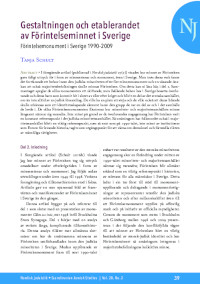Gestaltningen och etablerandet av Förintelseminnet i Sverige: Förintelsemonument i Sverige 1990–2009
Translated Title
The design and establishment of Holocaust memorials in Sweden: Holocaust memorials in Sweden 1990-2009
Author(s)
Schult, Tanja
Publication Name
Publication Date
Abstract
I föregående artikel (publicerad i Nordisk judaistik 27(2)) visades hur minnet av Förintelsen gavs tidigt uttryck för i form av minnesstenar och monument, även i Sverige. Men trots dessa verk fanns det fortfarande ett behov inom den judiska minoriteten efter fler minnesmonument och en växande önskan att också majoritetsbefolkningen skulle minnas Förintelsen. Om detta kan ni läsa här, i del 2. Sammantaget speglar de olika monumenten ett skiftande, men ihållande behov hos i Sverige bosatta överlevande och deras barn som kommit hit i slutet av eller efter kriget och blivit en del av det svenska samhället, om än inte alltid av en judisk församling. De ville ha en plats att sörja och de ville också att deras lidande skulle erkännas som ett identitetsskapande element inom den grupp de var en del av och i det samhälle de levde i. De olika Förintelsemonumenten illustrerar hur minoritets- och majoritetssamhällets minne långsamt närmar sig varandra. Inte minst på grund av de överlevandes engagemang har Förintelsen varit en konstant referenspunkt i det judiska minoritetssamhället. Så småningom har folkmordet också i majoritetssamhället blivit en viktig referenspunkt, som så sent som på 1990-talet, inte minst av institutioner som Forum för levande historia, tagits som utgångspunkt för att värna om demokrati och förmedla vikten av mänskliga rättigheter.
Translated Abstract
This article builds on and refers
to Part 1, which ends with a presentation of the
monument ‘Do not forget us’, erected in 1998 next
to Stockholm’s Great Synagogue. Part 2 begins with
an analysis of the long, complex history of the work.
This analysis allows more general conclusions to be
drawn on how the painful memories of the Holocaust
were renegotiated within the Jewish minority in
Sweden. While the construction of the Holocaust
Monument by the late 1990s was the result of the
involvement of the Swedish minority, a change
occurred in the mid-1990s: the minority and majority
societies grew closer; the Holocaust came to be
widely recognised as an important reference point
in history and is perceived as relevant to all people
in Sweden. This in turn led to support for the raising
of monuments and participation in monument
initiatives by representatives from outside the
Jewish minority, and since the turn of the millennium
Holocaust monuments have been erected on public
land and on the initiative of the official authorities.
By means of monuments raised in Stockholm and
Gothenburg between 1998 and 2009, the conflicted
pathway to the memory of the Holocaust has become
an important part of Swedish-Jewish identity, and
the memory of the Holocaust has gradually been
integrated into the collective memory of the majority
population.
to Part 1, which ends with a presentation of the
monument ‘Do not forget us’, erected in 1998 next
to Stockholm’s Great Synagogue. Part 2 begins with
an analysis of the long, complex history of the work.
This analysis allows more general conclusions to be
drawn on how the painful memories of the Holocaust
were renegotiated within the Jewish minority in
Sweden. While the construction of the Holocaust
Monument by the late 1990s was the result of the
involvement of the Swedish minority, a change
occurred in the mid-1990s: the minority and majority
societies grew closer; the Holocaust came to be
widely recognised as an important reference point
in history and is perceived as relevant to all people
in Sweden. This in turn led to support for the raising
of monuments and participation in monument
initiatives by representatives from outside the
Jewish minority, and since the turn of the millennium
Holocaust monuments have been erected on public
land and on the initiative of the official authorities.
By means of monuments raised in Stockholm and
Gothenburg between 1998 and 2009, the conflicted
pathway to the memory of the Holocaust has become
an important part of Swedish-Jewish identity, and
the memory of the Holocaust has gradually been
integrated into the collective memory of the majority
population.
Topics
Genre
Geographic Coverage
Copyright Info
This work is licensed under a Creative Commons Attribution-NonCommercial-NoDerivatives 4.0 International License.
Original Language
Volume/Issue
28(2)
Page Number / Article Number
39-62
Related
DOI
Link
Link to article including link to pdf, Gestaltningen och etablerandet av Förintelseminnet i Sverige: Förintelsemonument i Sverige 1990–2009
Bibliographic Information
Gestaltningen och etablerandet av Förintelseminnet i Sverige: Förintelsemonument i Sverige 1990–2009. 2017: 39-62. https://archive.jpr.org.uk/10.30752/nj.67751




